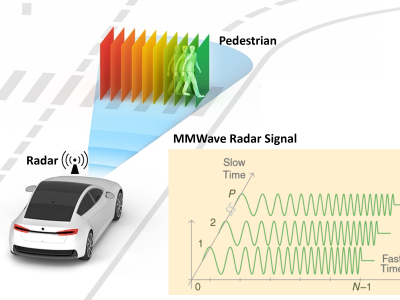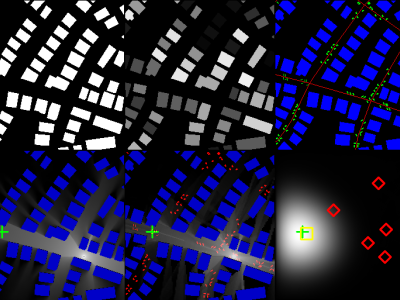CRAWDAD mannheim/compass (v. 2006-09-13)

- Citation Author(s):
-
Thomas King (University of Mannheim, Germany)Stephan Kopf (University of Mannheim, Germany)Thomas Haenselmann (University of Mannheim, Germany)Christian Lubberger Lubberger (University of Mannheim, Germany)Wolfgang Effelsberg (University of Mannheim, Germany)
- Submitted by:
- CRAWDAD Team
- Last updated:
- DOI:
- 10.15783/C7F30Q
- Data Format:
 394 views
394 views
- Categories:
Abstract
Traces of signal strength of 802.11 APs for the COMPASS positioning system.
Note: This dataset has multiple versions. The dataset file names of the data associated with this version are listed below, under the 'Traceset' heading and can be downloaded under 'Dataset Files' on the right-hand side of the page.
COMPASS is a positioning system based on 802.11 and digital compasses. We apply an two-stage fingerprinting approach: In the training phase, we sample the signal strength of neighboring access points for selected orientations at each reference point and store the data in a database. During the positioning phase, the orientation of the user is utilized to preselect a subset of the training data and based on this data compute her position.
last modified :
2006-11-14release date :
2006-09-13date/time of measurement start :
2006-02-11date/time of measurement end :
2006-03-09collection environment :
Positioning systems are one of the key elements required by location-based services. We design and implement a positioning system called COMPASS which is based on 802.11-compliant network infrastructure and digital compasses. On the mobile device, COMPASS samples the signal strength values of different access points in its communication range and utilizes the orientation of the user to preselect a subset of the training data. The remaining training data is used by a probabilistic positioning algorithm to determine the position of the user. While prior systems show limited accuracy due to blocking effects caused by the human body, we apply digital compasses to detect the orientations of the users so that they can deal with these blocking effects. After a short period of training the COMPASS system achieves an average error distance of less than 1.65 meters in the experimental environment of 312 square meters.network configuration :
The test environment is equipped with five Linksys / Cisco WRT54GS and four Lancom L-54g access points. All access points support 802.11b and 802.11g. One Lancom and all Linksys access points are located on the same floor as our testing area whereas three Lancom access point are located in other places inside the building. The exact position of the access points located inside the testing area is marked by squares in the floor plan (see the download link below).data collection methodology :
We deployed our positioning system in the hallway of an office building on the campus of the University of Mannheim. The operation area is nearly 15 meters in width and 36 meters in length, covering an area of approximately 312 square meters. The floor plan of the testing area is shown in the floor plan figure (see the download link below). The large hallway in the left part of the map is connected by two narrow hallways that are separated by rooms such as archives and a kitchen. We marked the floor plan (see the download link below) with markers depicting the grid of the reference points (light-colored dots) and the online measurement points (dark dots). The access points are marked by squares. As a client, we used a Lucent Orinco Silver PCMCIA network card supporting 802.11b. We collected the signal strength samples on an IBMThinkpad R51 running Linux kernel 2.6.13 and Wireless Tools 28pre. To obtain the orientation of the user we used the Silicon Laboratories C8051F350 Digital Compass Reference Design Board. This device provides a USB-to-Serial bridge to access the data and is powered by the USB electricity supply. We calibrated the compass in the middle of the operation area. In a closer area around the calibration point we measured a variation of 1 degree. However, variations up to 23 degree were rarely detected at a few points of the testing area. These measurement errors occured always close to electromagnetic objects such as high-voltage power lines and electronic devices.Traceset
mannheim/compass/signalstrength
A traceset of signal strength collected from 802.11 APs for the COMPASS positioning system.
- files: offline.tar.gz, online.tar.gz
- description: A traceset of signal strength collected from 802.11 APs for the location estimation used by the COMPASS positioning system.
- measurement purpose: Location-aware Computing, Positioning Systems
- methodology: The grid of reference points applied to the operation area includes 166 points with a spacing of 1 meter (see the light-colored dots in the floorplan figure). During the offline phase, the signal strength was measured at reference points for different orientations. We then randomly selected 60 coordinates and orientations for the online phase.
- last modified: 2006-11-14
- dataname: mannheim/compass/signalstrength
- version: 20060913
- change: the initial version
- release date: 2006-09-13
- date/time of measurement start: 2006-02-11
- date/time of measurement end: 2006-03-09
mannheim/compass/signalstrength Traces
- offline: A trace of signal strength values from 802.11 APs measured at reference points for different orientations.
- configuration: During the offline phase, the signal strength was measured at reference points for different orientations. We collected 110 signal strength measurements at each reference point and for each orientation. This leads to 146,080 measurements for the offline phase. We spent over 10 hours to collect all the data.
- format: t="Timestamp"; id="MACofScanDevice"; pos="RealPosition"; degree="orientation"; "MACofResponse1"="SignalStrengthValue","Frequency","Mode"; ... "MACofResponseN"="SignalStrengthValue","Frequency","Mode" t: timestamp in milliseconds since midnight, January 1, 1970 UTC id: MAC address of the scanning device pos: the physical coordinate of the scanning device degree: orientation of the user carrying the scanning device in degrees MAC: MAC address of a responding peer (e.g. an access point or a device in adhoc mode) with the corresponding values for signal strength in dBm, the channel frequency and its mode (access point = 3, device in adhoc mode = 1)
- description: A trace of signal strength values from 802.11 APs measured at reference points for different orientations for the offline phase of the COMPASS positioning system.
- last modified: 2006-11-14
- dataname: mannheim/compass/signalstrength/offline
- version: 20060913
- change: the initial version
- release date: 2006-09-13
- date/time of measurement start: 2006-02-11
- date/time of measurement end: 2006-03-09
- url: /download/mannheim/compass/offline.tar.gz
- online: A trace of signal strength, which is derived from mannheim/compass/signalstrength/offline.
- configuration: We randomly selected 60 coordinates and orientations for the online phase. The only condition to select a point inside the testing area as an online set point is that it is surrounded by four reference points. Again, we collected 110 signal strength measurements for each online set point, leading to 6,600 measurements in total. In Figure 3 the online set points are marked by dark dots.
- format: t="Timestamp"; id="MACofScanDevice"; pos="RealPosition"; degree="orientation"; "MACofResponse1"="SignalStrengthValue","Frequency","Mode"; ... "MACofResponseN"="SignalStrengthValue","Frequency","Mode" t: timestamp in milliseconds since midnight, January 1, 1970 UTC id: MAC address of the scanning device pos: the physical coordinate of the scanning device degree: orientation of the user carrying the scanning device in degrees MAC: MAC address of a responding peer (e.g. an access point or a device in adhoc mode) with the corresponding values for signal strength in dBm, the channel frequency and its mode (access point = 3, device in adhoc mode = 1)
- description: A trace of signal strength, which is derived from mannheim/compass/signalstrength/offline for online phase of the COMPASS positioning system.
- last modified: 2006-11-14
- dataname: mannheim/compass/signalstrength/online
- version: 20060913
- change: the initial version
- release date: 2006-09-29
- date/time of measurement start: 2006-02-11
- date/time of measurement end: 2006-03-09
- url: /download/mannheim/compass/online.tar.gz
Instructions:
The files in this directory are a CRAWDAD dataset hosted by IEEE DataPort.
About CRAWDAD: the Community Resource for Archiving Wireless Data At Dartmouth is a data resource for the research community interested in wireless networks and mobile computing.
CRAWDAD was founded at Dartmouth College in 2004, led by Tristan Henderson, David Kotz, and Chris McDonald. CRAWDAD datasets are hosted by IEEE DataPort as of November 2022.
Note: Please use the Data in an ethical and responsible way with the aim of doing no harm to any person or entity for the benefit of society at large. Please respect the privacy of any human subjects whose wireless-network activity is captured by the Data and comply with all applicable laws, including without limitation such applicable laws pertaining to the protection of personal information, security of data, and data breaches. Please do not apply, adapt or develop algorithms for the extraction of the true identity of users and other information of a personal nature, which might constitute personally identifiable information or protected health information under any such applicable laws. Do not publish or otherwise disclose to any other person or entity any information that constitutes personally identifiable information or protected health information under any such applicable laws derived from the Data through manual or automated techniques.
Please acknowledge the source of the Data in any publications or presentations reporting use of this Data.
Citation:
Thomas King, Stephan Kopf, Thomas Haenselmann, Christian Lubberger, Wolfgang Effelsberg, mannheim/compass, https://doi.org/10.15783/C7F30Q , Date: 20060913
















